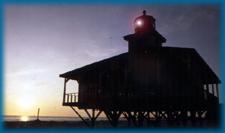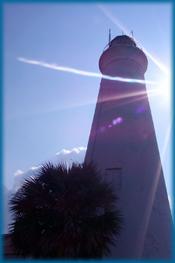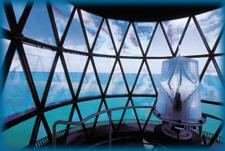|
|

|
|
Port Boca Grande Lighthouse.
Photo courtesy of the Florida Division of Historical Resources.
|
Lighthouses have guided mariners for thousands of years and have long symbolized romance,
genius, and awe. The world's first recorded lighthouse, a 450-foot tower called the Pharos
of Alexandria and built in Egypt around 300 B.C., was one of the "Seven Wonders of the World."
America's first lighthouse was constructed of stone on Little Brewster Island in Boston
Harbor in 1716. Lighthouses erected on the coasts of England and Scotland showed engineers
how to build on exposed, sea-swept sites, bringing lighthouses out of the safety of harbors
and onto rocky, dangerous reefs. In 1823 a French physicist named Augustin Fresnel (pronounced fray-NEL) used
prisms, mirrors, and magnifying bull's-eyes to gather and reflect light at many times its
original candlepower. Seven types, called "orders," of Fresnel lenses were developed.
The first three orders were for seacoast lights, while orders four through six were smaller,
for bay or harbor lights. Fresnel's lenses soon illuminated America's coastlines and the
modern lighthouse was born.

|
|
St. Marks Lighthouse.
Photo courtesy of the Florida Division of Historical Resources.
|
Florida's first coastal navigational aid was a 1586 Spanish watchtower at
St. Augustine.
The first true lighthouse was a 73-foot harbor light built there in 1824. But offshore
masonry towers proved vulnerable to storms-the lighthouse built in 1827 on
Sand Key, near
Key West, collapsed in an 1846 hurricane,
killing 14 people seeking refuge there. A new screw-pile design provided stronger anchoring in
sandy soils and its open iron
framework offered less resistance to storm force winds and waves. Between 1852 and
1900, more than a dozen pile lighthouses were built along Florida's dangerous reefs
and they remain in use today. Heat, insects, storms, supply delays, and disputes with
Native Floridians influenced the construction of most towers. A solitary life of
deprivation and danger challenged the keepers and their families.

|
|
Cape Florida Lighthouse.
Photo courtesy of VISIT FLORIDA.
|
Each one of the state's 30 lighthouses has a distinctive daytime color and a unique nocturnal
light sequence to aid in navigating more than 1,100 miles of coastline. By 1939,
lighthouses were placed under the auspices of the
Coast Guard. Lightkeepers became
obsolete in the 1960s with the
Lighthouse Automation and Modernization Project (LAMP),
which uses electric timers, photosensitive cells, and backup generators instead of people
to light sailors' passage to safety. The public's desire to preserve these coastal
guardians has resulted in most of Florida's lighthouses being placed on the
National Register
of Historic Places. Many are now parts of parks, wildlife refuges, or recreational areas.
To learn more about Florida's Lighthouses, visit
The Florida Lighthouse Association and
The Yachting Club of America.
LIGHTS ON THE FLORIDA REEF
The fixed white light of Fowey Rocks,
And Carysfort's white flash,
Both may be seen from the middle
Of a twenty-three mile dash.
Alligator Reef'sred, white and white
Lies thirty miles away.
Log thirty more, Sombrero white
Points to Honda Bay.
Then comes the Shoals American,
White flashing through the night,
Just fifteen miles from the white Key West,
Twenty from Sand Key's twinkling white.
The Marquesas are unlighted;
But on Rebecca's Shoal,
A white and red is sighted,
Warning from the wreck and dole.
Sixteen miles to Dry Tortugas
With a white light on the fort,
Three more to the flash of Loggerhead,
And all's clear to a western port.
- Kirk Monroe
|












